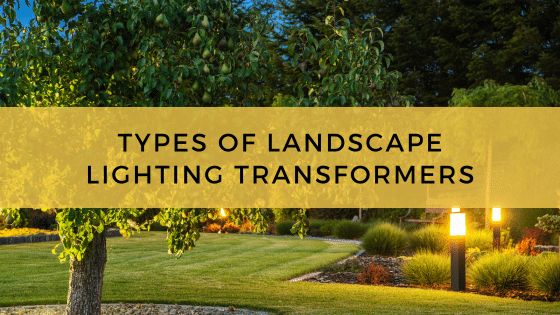
Although there are many types of landscape lighting transformers, they all have a few things in common, including that they are all designed to safely step-down voltage from line supply into a safer, low voltage form. Landscape lighting transformers are also built to be wear and weather resistant, as they must be able to handle the elements without creating a safety hazard.
Where the transformers differ is the technology that drives them, whether electronic or magnetic, and their capacity.
Landscape lighting transformers are often overlooked as a critical system component, but every outdoor lighting system needs one to ensure safe and reliable operation.
What Does a Transformer Do for a Landscape Lighting System?
A landscape lighting transformer serves the same purpose that any low voltage transformer does for a lighting system – it takes the high voltage current from the main power supply and stepping it down into a safer, low voltage form – typically between 12 and 15 volts. In addition to improving safety protecting installers from dangerous electrical discharges, this low voltage current is necessary for most landscape lights, which are designed for low voltage supply.
What is the Difference Between an Electric and Magnetic Transformer?
The many types of landscape lighting transformers can be grouped into two categories: electronic transformers and magnetic transformers. Here is a quick look at each:
- Electronic transformers – Electronic transformers step down line voltage to low voltage by first increasing the current’s frequency before passing through a miniature coil that generates the magnetic field needed to induce a lower voltage current in a second coil – the low voltage power that is fed to the landscape lighting fixtures.Electronic transformers are more compact than magnetic transformers, given their micro coil design. They are also less expensive, but electronic transformers occasionally have compatibility issues with LED landscape lighting. They also generate more heat, which must be controlled, and they must be positioned closer to the lights due to potential voltage losses.
- Magnetic transformers – Magnetic transformers also step down line voltage using a pair of coils. The primary coil’s electrical current creates a magnetic field that induces a current in the second coil. This second coil has a lower number of windings (about 1/10 of the primary coil), which results in a proportionally smaller voltage, from 150 volts to 12-15 volts.There are two types of magnetic transformers: stacked core transformers and toroidal transformers.
Stacked core transformers are built with a set of copper winding-wrapped sheets that together act as the transformer’s core. This type of magnetic transformer is less expensive to manufacture but is less efficient than a toroidal magnetic transformer.
Toroidal magnetic transformers are built with a donut-shaped core around which the copper windings are wrapped. This is a more efficient transformer design but is more expensive to produce.
When installing a landscape lighting system, part of the transformer selection process will come down to picking between an electronic and magnetic transformer design.
What to Look for in a Landscape Lighting Transformer
When selecting a landscape lighting transformer, the following considerations are important:
- Voltage output – Low voltage lighting transformers output a tight range of voltages, but it is still essential for installers to verify that their lighting fixtures are compatible with the transformer’s voltage specifications.
- Power capacity – Landscape lighting transformers have capacities measured in voltage. Make sure that your transformer has the capacity for your landscape lights.
- Housing and design – Landscape lighting transformers are available in a variety of designs and sizes. When selecting yours, the goal is to choose one that blends in with your property for aesthetic reasons and to prevent people from tampering with it.
In addition to the above considerations, the following features are recommended for landscape lighting applications:
- A fully dimmable design – Landscape lighting systems must be controllable since they are used outdoors. If your transformer is compatible with dimmers, it can precisely control the amount of illumination your lights are generating.
- A secondary connection block – A secondary connection block simplifies installation by providing a simple wiring interface for installers to work with.
- Secondary protection – If the landscape lighting transformer is designed with secondary protection, it will not pose a safety hazard if the primary protection mechanism fails. This added protection is highly recommended for outdoor lighting applications.
- A stainless steel build – A stainless steel housing provides excellent impact protection and shielding from inclement weather. Stainless steel is also corrosion-resistant, which is a must for exterior lighting applications.
A Lighting Expert Can Help Select the Ideal Transformer for any Landscape Lighting System
Landscape lighting systems require a reliable, compatible transformer to safely convert line voltage to low voltage that outdoor fixtures rely on. The challenge is identifying the right transformer for your project. In this regard, a trusted lighting expert can provide insight into the right choice for your property.






